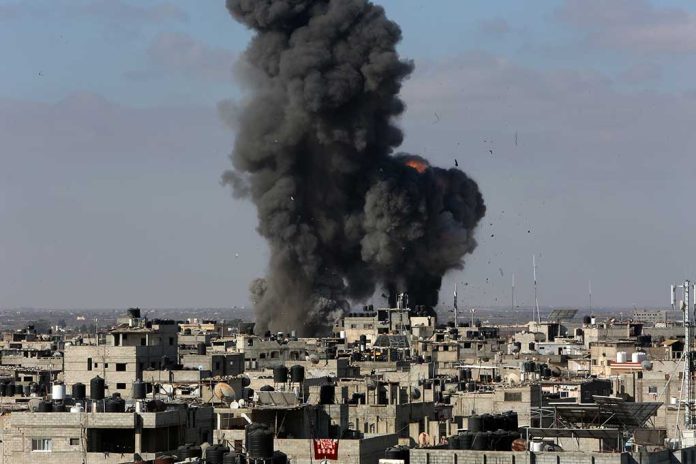
The Israeli Air Force has struck a significant blow to Hezbollah by destroying a major command center in Beirut, leaving many to ponder the future regional implications.
At a Glance
- Massive Israeli airstrike killed Hezbollah leader Hassan Nasrallah.
- The strike targeted an underground Hezbollah compound in Dahiyeh, a predominantly Shiite suburb in southern Beirut.
- Residents heard up to 10 explosions, and the area affected was larger than a city block.
- Six deaths and dozens of injuries have been confirmed, with some people still missing.
- Nasrallah’s death is a major blow to Hezbollah, depriving it of his experience and leadership.
Operation “New Order” Unfolds
On September 27, 2024, the Israeli Air Force launched Operation “New Order,” targeting Hezbollah’s fortified underground command center in Beirut’s Dahiyeh suburb. The 69th Squadron from Hatzerim Airbase utilized GPS-aided GBU-31(V)3/B JDAM bunker-buster bombs to carry out the mission. Hezbollah leader Hassan Nasrallah and his deputy, Ali Karaki, were killed in the strike, marking a significant escalation in hostilities. The operation sent a potent warning to Iran and its proxies.
The bombardment resulted in the destruction of multiple high-rise apartment towers, causing significant structural damage. Residents reported hearing up to ten explosions, with the affected area spanning larger than a city block. Visual evidence released by the Israeli military confirmed that at least eight F-15I warplanes were involved in the strike.
Senior Israeli Air Force officials say the strike in Beirut yesterday killing Hezbollah terror chief Hassan Nasrallah went smoothly with no errors or enemy fire on the IAF warplanes.
"Everything we planned was executed precisely, with no errors, both in intelligence, the… pic.twitter.com/d9BaNy6UUF
— Emanuel (Mannie) Fabian (@manniefabian) September 28, 2024
Human and Emotional Toll
Onlookers and residents flocked to the site following the airstrike, searching for missing relatives amidst the rubble. The Lebanese health ministry confirmed six deaths and dozens of injuries, with several individuals still unaccounted for. The immense emotional distress was palpable among those inspecting the damage. Hezbollah workers were seen excavating the site, though state security personnel and investigators were notably absent.
In light of the chaos, supporters of Nasrallah reaffirmed their commitment to the struggle, despite the devastating loss. Experts indicated that the bombs used in the attack were likely 2,000-pound BLU-109 penetrator bombs with JDAM precision guidance systems, which were recently transferred to Israel by the United States.
Regional Repercussions
Following Nasrallah’s assassination, Israeli airstrikes targeted areas near Beirut again on Saturday evening, further escalating the conflict. Both Hezbollah and Israel have vowed to continue fighting, signaling potentially prolonged hostilities. The death of Nasrallah represents a significant detriment to Hezbollah, stripping the organization of his seasoned leadership and strategic capabilities.
Israeli Prime Minister Benjamin Netanyahu ordered the assassination to prevent Nasrallah from rebuilding Hezbollah. President Biden described the assassination as a measure of justice, yet underscored the need for a diplomatic solution. With approximately 500,000 individuals displaced in Lebanon due to the ongoing conflict, the regional and humanitarian implications are vast and uncertain.
❗️🇮🇱⚔️🇱🇧🇮🇷 – The Israel Defense Force (IDF) confirmed the elimination of Hassan Nasrallah, secretary general of Hezbollah, in a precision strike carried out on the Hezbollah command bunker in the suburb of Dahieh, south of Beirut.
The operation, called "New Order", also… pic.twitter.com/AWrrusFV2V
— 🔥🗞The Informant (@theinformant_x) September 28, 2024
Sources:
- Israel kills Hezbollah leader Nasrallah in airstrike
- Images offer a close-up look at the site of Nasrallah’s assassination
- Israel Strikes Lebanon Again After Killing Hezbollah Leader







